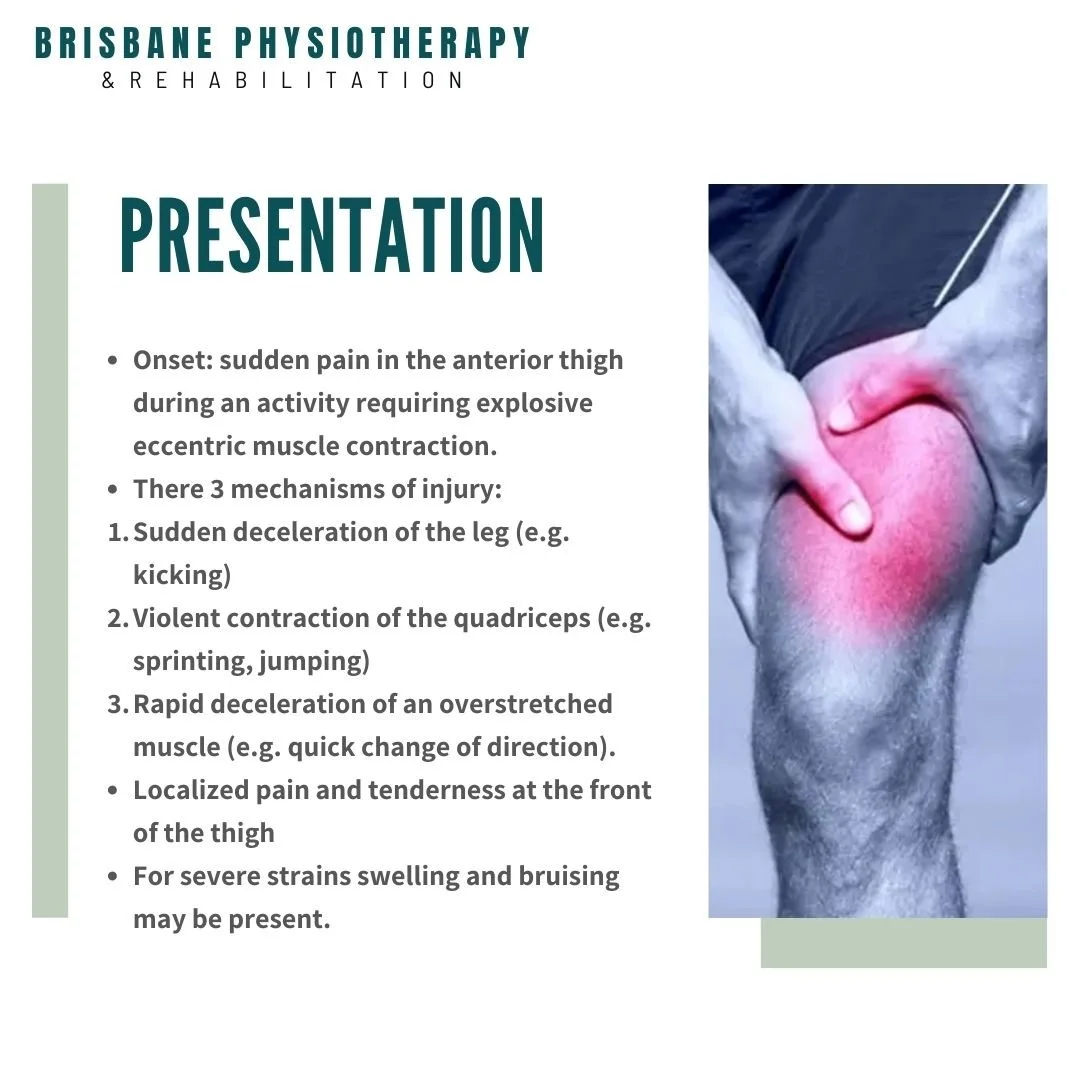Quadricep Strains
What is a Quadricep Strain?
Quadricep Strain Overview
Quadricep Strain Description
A quadriceps muscle strain is an acute tearing injury of the quadriceps.
Quadricep strains are most common in the rectus femoris, which is more vulnerable to strain as it passes over two joints: the hip and the knee.
Injury to the quadricep muscle group can be painful and debilitating.
Quadricep tendon rupture is a uncommon debilitating diagnosis, occurring more often in older male populations.
Anatomy of a Quadricep Strain
The quadricep muscle group is composed of 4 subcomponents: rectus femoris, vastus lateralis, vastus medialis and vastus intermedius.
Presentation of a Quadricep Strain
Onset: sudden pain in the anterior thigh during an activity requiring explosive eccentric muscle contraction.
There a generally three mechanisms of injury for the quadriceps:
Sudden deceleration of the leg (e.g. kicking)
Violent contraction of the quadriceps (e.g. sprinting, jumping)
Rapid deceleration of an overstretched muscle (e.g. quick change of direction)
Localized pain and tenderness at the front of the thigh
For severe strains swelling and bruising may be present.
Quadricep Strain Grades
Grade 1 (mild) strain: affects only a limited number of fibers - is a minor injury with pain on resisted active contraction and on passive stretching. A twinge may be felt in the thigh and a general feeling of tightness. An area of local spasm is palpable at the site of pain. An athlete with such a strain may not cease activity at the time of the pain but will usually notice the injury after cooling down or the following day.
Grade 2 (Moderate) strains: nearly half of muscle fibres torn – the athlete may feel a sudden sharp pain when running, jumping or kicking. It may cause significant pain on stretching as well as on unopposed active contraction. There is usually a moderate area of inflammation surrounding a tender palpable lesion. The athlete with a grade II strain is generally unable to continue the activity.
Grade 3 (Complete tears): of the rectus femoris occur with sudden onset of severe pain at the front of the thigh and disability during intense activity. Bad swelling will appear immediately and significant bruising within 24 hours. A muscle fibre defect is usually palpable when the muscle is contracted. In the long term, they resolve with conservative management, often with surprisingly little disability.
Quadricep Strain Treatment
Managing your Quadricep Strain
Quadricep Strain Rehabilitation protocol
Stage 1 (control hemorrhage):
RICE: rest, ice, compression, elevation
Soft tissue massage: gentle massage
Stretching: gentle stretch till onset of pain
Strengthening: static muscle contraction is possible
Stage 2 (restore and maintain pain-free range and muscle strength)
Maintain compression: ice after exercise
Soft tissue release: gentle massage
Stretching: increase stretches
Strengthening: static muscle contraction through range, stationary bike, pool (walk/swim/kick), concentric/eccentric exercises
Stage 3 (functional rehabilitation)
Soft tissue release: moderate massage
Maintain stretching
Strengthening: gradually increase stage 2 exercise repetition, speed and resistance
Stage 4 (gradual return to sport)
Soft tissue massage: firm
Exercises: sports specific exercises, agility drills, plyometrics
Must complete full training before return to sport
Quadricep Strain Prognosis
Mild strain = 1-2 weeks
Moderate strain = 2-4 weeks
Severe strain = 6-12 weeks



